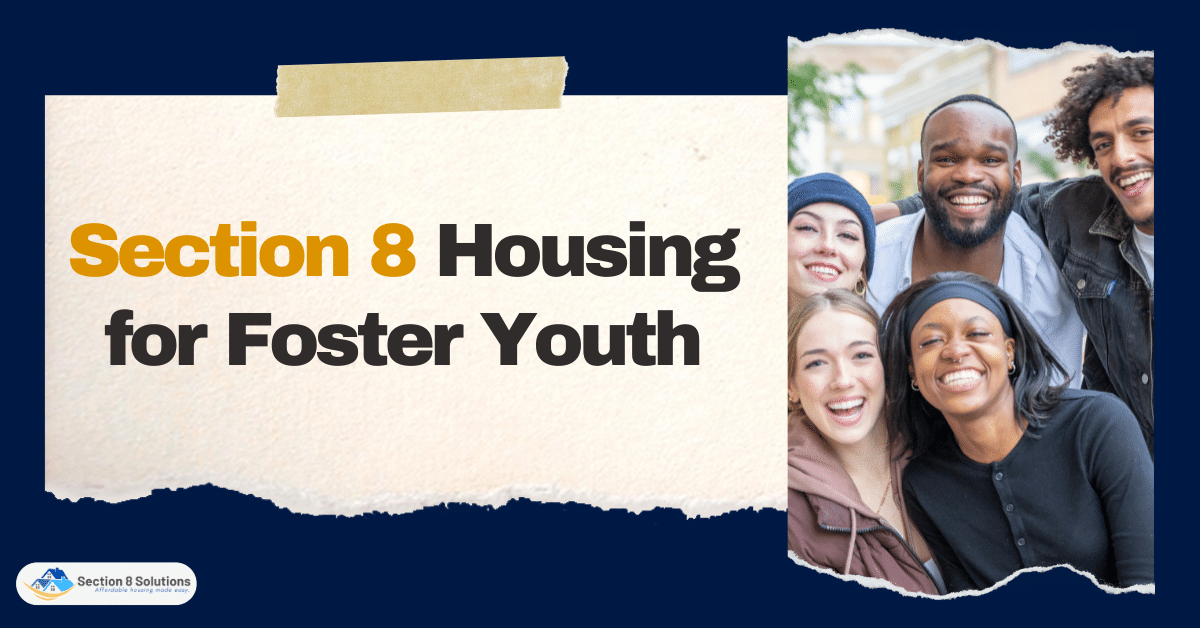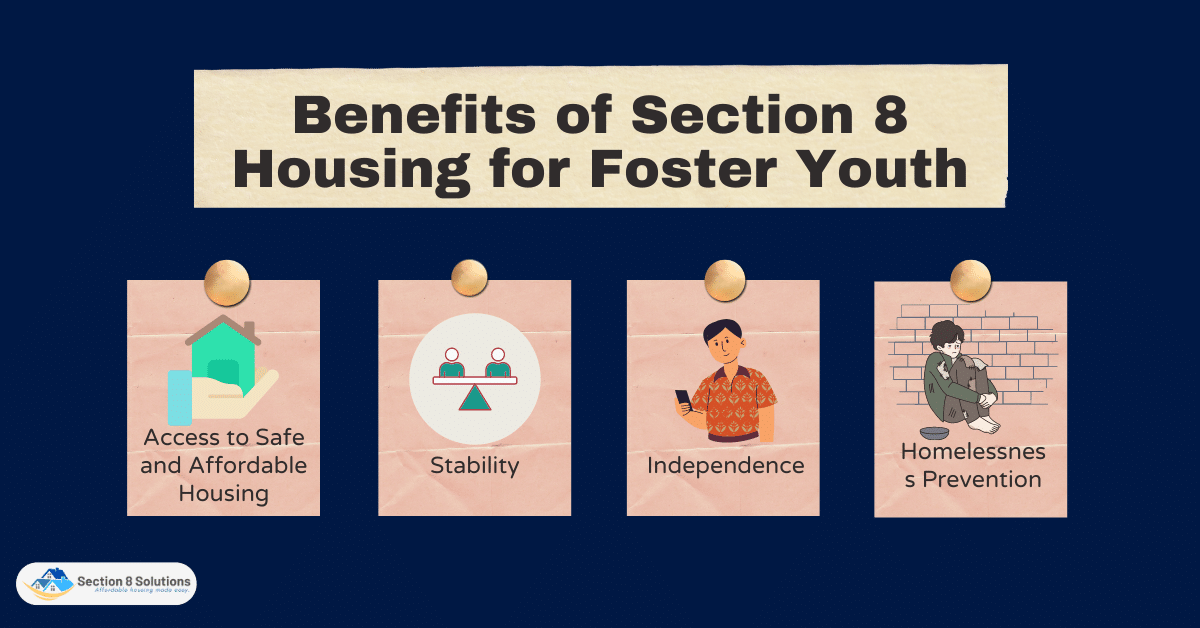Section 8 Housing can provide crucial support to young adults who have aged out of the foster care system. Through the program, eligible youth can access rental assistance and other supportive services to help them secure safe and affordable housing as they transition to independent living.
In this blog post, we’ll explore the eligibility requirements, application process, benefits, and limitations of Section 8 Housing for Foster Youth.

Eligibility
Section 8 housing can be an essential resource for foster youth who may face significant challenges in securing safe and affordable housing. Eligibility for Section 8 housing is determined by several factors, including age, income, and legal status. Foster youth who meet the program’s eligibility requirements may qualify for rental assistance to help them secure stable housing.
To be eligible for Section 8 housing, foster youth must generally be at least 18 years old, but some may be eligible as young as 16 or 17 depending on the state. They must also meet income requirements set by the U.S. Department of Housing and Urban Development (HUD). These income limits vary by location and family size, but generally, foster youth must have a household income that is at or below 50% of the area median income to be eligible for rental assistance.
Adopted or aging-out of foster care youth may be eligible for Section 8 housing. Young people in foster care may have difficulty obtaining accommodation if they meet the requirements. It’s very uncommon for youngsters in foster care to be without a stable income or the proper paperwork. There are areas where it can be difficult for foster adolescents to find Section 8 housing.

Benefits of Section 8 Housing for Foster Youth
Section 8 housing, also known as the Housing Choice Voucher Program, can be a crucial resource for foster youth who are transitioning to adulthood and facing the challenges of finding and maintaining stable housing. Here are some benefits of Section 8 housing for foster youth:

1. Access to Safe and Affordable Housing
Foster adolescents find safe and affordable living difficult. Many foster care graduates lack the resources and support to find stable homes, which can lead to homelessness and housing instability. Section 8 housing helps disadvantaged youth transition into adulthood by providing safe, affordable housing.
Foster youth can get safe, decent Section 8 housing. Water, heat, and electricity are included. Foster youth can choose Section 8 housing that suits their needs and preferences. Section 8 housing can assist foster youngsters create stable, productive lives by providing safe, affordable housing.

2. Stability
Foster youth can also avoid homelessness with Section 8 housing. These adolescents typically have to stay in shelters or couch-surfing, which can harm their health and success. Section 8 housing gives foster youngsters a stable home, minimizing stress and uncertainty. Stable housing can be a crucial factor in helping foster youth build a sense of stability and establish themselves as independent adults. Section 8 housing provides a consistent and predictable source of housing assistance, which can help foster youth focus on their education, employment, and other important aspects of their lives.
3. Independence
Section 8 housing allows foster youth to live independently and make their own decisions about where they live and how they want to live. This can be an important step in the transition to adulthood and can help foster youth build confidence and develop essential life skills.
Foster youth, who have often lived in unstable environments, must learn to live independently. Foster youngsters can choose their own housing and feel ownership over their houses through Section 8 housing. As they grow up, this freedom is vital. Living independently can also help foster adolescents create social networks outside of the foster care system, which can improve their long-term well-being. Section 8 housing can help foster youngsters become self-sufficient.

4. Homelessness Prevention
Additionally, Section 8 housing can also help to prevent foster youth from experiencing housing instability, such as frequent moves and unstable living situations. This instability can be detrimental to a young person’s development and can lead to a variety of negative outcomes, including difficulties with education, employment, and mental health. By providing stable and affordable housing, Section 8 can help foster youth build a foundation of stability and security, which can set them up for success in other areas of their lives.

Applying for Section 8 Housing
Foster youth without housing experience may find applying for Section 8 housing intimidating. Section 8 housing can help foster youth move to adulthood. This section covers foster youth’s Section 8 housing application procedure, including papers, waiting list, and acceptance.
Finding and Applying for Available Units
To find available Section 8 housing units, foster youth can contact their local housing authority or search online using resources such as GoSection8.com. These resources typically provide information on available units, including their location, size, and rent amount.
To apply for Section 8 housing, foster youth may need to provide documentation such as proof of income, identity, and legal status. This documentation may vary depending on the specific requirements of the local housing authority. Foster youth can contact their local housing authority for more information on the application process and required documentation.

Required Documentation
When applying for Section 8 housing, foster youth are required to provide documentation to prove their eligibility. The required documentation can vary depending on the state and local housing authority. In this section, we will discuss the types of documentation foster youth may need to provide when applying for Section 8 housing.
- Proof of identity: Foster youth will need to provide a government-issued photo ID, such as a driver’s license or passport, to verify their identity.
- Proof of income: Foster youth must provide documentation to verify their income, including pay stubs, tax returns, or a letter from their employer.
- Proof of legal status: Foster youth who are not U.S. citizens must provide documentation to verify their legal statuses, such as a green card or work visa.
- Other documentation: Foster youth may also need to provide other documentation, such as proof of disability or proof of homelessness, depending on the specific eligibility requirements in their state or local area.
Providing the required documentation can be a crucial step in securing Section 8 housing for foster youth. It is important to carefully review the documentation requirements in your area and gather all necessary documents to ensure a smooth application process.

Waiting List and Approval Process
Foster youth may be placed on a Section 8 waiting list after applying, as unit availability varies by locality. The number of units, applicants, and housing authority qualifying rules affect wait times.
Once a unit becomes available, the foster youth’s eligibility and documents, including identification, income, and legal status, will be checked. Foster youth may receive Section 8 housing after verification. Housing authorities may prioritize applicants based on income, family size, and other reasons, so acceptance is not assured.

Challenges and Limitations of Section 8 Housing for Foster Youth
Foster youth can benefit from Section 8 housing, but it also has drawbacks that can make it hard for them to find safe, affordable housing. We’ll cover foster youth’s Section 8 housing issues and restrictions in this section.
Limited Availability: Section 8 foster kid housing has a shortage of units. Foster youth may have trouble getting Section 8 housing due to extensive waitlists. This may leave them homeless.
Stigma: Foster youth seeking Section 8 housing may experience stigma. Foster adolescents may have trouble finding housing because some landlords are reluctant to rent to program participants. Isolation and exclusion can harm their mental health.
Discrimination: Section 8 housing discrimination may also affect foster youngsters. Foster youth may have trouble finding safe, inexpensive homes due to landlords’ age, color, or other preferences. LGBTQ+ youth may experience additional discrimination and housing challenges.
Foster youth’s access to safe and inexpensive housing can be hampered by Section 8’s limits. Policymakers, housing authorities, and landlords must collaborate to ensure foster adolescents have stable and supportive housing as they transition to adulthood.

Opportunities for Advocacy and Support
Transitioning foster adolescents need safe, affordable housing. Section 8 housing can give young persons stability and independence, but it has drawbacks. In this part, we will examine how people and groups may lobby for greater Section 8 housing for foster adolescents and highlight options and help for those struggling to find a safe and affordable home.
1. Advocacy for Increased Access
Individuals and organizations can advocate for increased access to Section 8 housing for foster youth in a number of ways. This may include lobbying elected officials, raising awareness through social media campaigns or community events, and partnering with local housing authorities and nonprofits to develop and promote programs that support foster youth housing. It is important to work collaboratively with government agencies, community organizations, and housing providers to identify gaps in services and develop targeted solutions that meet the unique needs of foster youth.
2. Resources and Support
Foster youth who are struggling to access safe and affordable housing can find support through a variety of resources, including local housing authorities, nonprofit organizations, and community-based programs. These resources can provide assistance with everything from finding and applying for housing to navigating the application process and accessing financial assistance. It is important for foster youth to take advantage of these resources to ensure that they are able to secure stable and affordable housing as they transition to independent adulthood.
3. Collaboration and Partnership
Finally, government, community, and housing providers must collaborate to address foster children’s housing insecurity. This may involve creating and implementing specific initiatives and policies to increase affordable housing and foster youth financing and resources. Working together, we can help foster adolescents move to adulthood with safe, affordable housing.
Access to safe and affordable housing is a critical issue for foster youth as they transition out of the foster care system. By advocating for increased access to Section 8 housing, providing support and resources for those who are struggling to secure housing, and working collaboratively to address the issue of housing insecurity, we can help to ensure that foster youth have the stable and secure housing they need to succeed in their lives.

Conclusion
Section 8 housing can play a critical role in providing safe and affordable housing for foster youth, helping to promote stability, independence, and homelessness prevention. However, the challenges and limitations of Section 8 housing, such as limited availability and stigma, can make it difficult for foster youth to access this resource.
Individuals and groups must work with government agencies and housing providers to increase foster youngsters’ access to Section 8 housing. Foster youth can get help finding safe, affordable homes. We must all act to help foster youngsters succeed.












